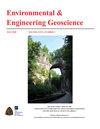Stability analysis of an old earth Samarkand Dam in Kazakhstan under rapid drawdown conditions
IF 0.7
4区 工程技术
Q4 ENGINEERING, ENVIRONMENTAL
引用次数: 0
Abstract
Despite being potential historical sites, old embankment dams are subjected to many stability challenges due to many factors, including a lack of sufficient stability assessment tools by the time the dam was built and changes in embankment material properties induced by natural and human activities. Therefore, with the current advancement in technology is of great importance to investigate the state of old embankment dams under different potential loading conditions. The stability challenges become of more significant concern when the embankment is subjected to a rapid drawdown loading scenario. In this study, the Samarkand dam located in Karaganda province in Kazakhstan which was put into operation in 1941 is investigated in terms of seepage and slope stability with the help of numerical modelling. Both steady and transient (rapid drawdown) flow conditions are taken into consideration. e finite element method-based modelling is achieved using SEEP/W and SLOPE/W of the GeoStudio software. From the analysis results, it was observed that the old dam can be subjected to a potential failure under rapid drawdown conditions as the minimum factor of safety values were decreasing with the increase in the drawdown rates. For instance, the minimum factor of safety from the instantaneous drawdown rate was equivalent to 32.85% less than the factor of safety retrieved from the long-term steady-state conditions. Also, from Analysis of Variance (ANOVA), a p-value of 9.97× 10-29 was obtained after subjecting the factor of safety values from instantaneous, 5 days, 10 days, and 1 m per day drawdown rates to ANOVA, indicating that the factor of safety differences among the analyzed drawdown rates were statistically significant.哈萨克斯坦古老撒马尔罕大坝快速落水条件下的稳定性分析
尽管是潜在的历史遗迹,但由于许多因素,包括大坝建成时缺乏足够的稳定性评估工具以及自然和人类活动引起的堤防材料特性的变化,旧堤防大坝受到许多稳定性挑战。因此,随着技术的进步,研究不同潜在荷载条件下老旧堤防坝体的状态具有重要意义。当路堤承受快速下拉荷载时,稳定性挑战变得更加重要。本文以1941年投入运行的哈萨克斯坦卡拉干达省撒马尔罕大坝为研究对象,采用数值模拟的方法对坝体渗流和边坡稳定性进行了研究。考虑了稳态和瞬态(快速下降)流动条件。利用GeoStudio软件的SEEP/W和SLOPE/W实现基于有限元法的建模。分析结果表明,随着落水速率的增大,最小安全系数逐渐减小,旧坝在快速落水条件下可能发生潜在破坏。例如,从瞬时降速获得的最小安全系数相当于从长期稳态条件获得的安全系数低32.85%。从方差分析(ANOVA)中,将瞬时、5天、10天、1 m / d的缩水率的安全系数进行方差分析,得到的p值为9.97× 10-29,表明所分析的缩水率之间的安全系数差异具有统计学意义。
本文章由计算机程序翻译,如有差异,请以英文原文为准。
求助全文
约1分钟内获得全文
求助全文
来源期刊

Environmental & Engineering Geoscience
地学-地球科学综合
CiteScore
2.10
自引率
0.00%
发文量
25
审稿时长
>12 weeks
期刊介绍:
The Environmental & Engineering Geoscience Journal publishes peer-reviewed manuscripts that address issues relating to the interaction of people with hydrologic and geologic systems. Theoretical and applied contributions are appropriate, and the primary criteria for acceptance are scientific and technical merit.
 求助内容:
求助内容: 应助结果提醒方式:
应助结果提醒方式:


